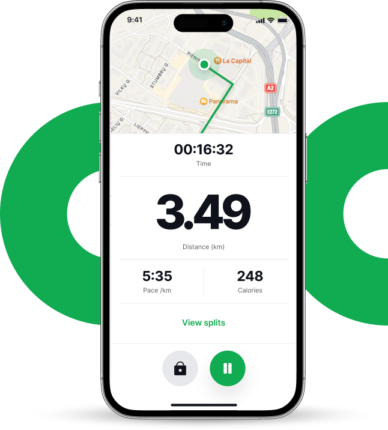Taking a break from running is common – an injury, lockdown, or daily responsibilities can force you to abandon your routine. And the longer the break, the harder it can be to start running again.
Both coming back after a long break from running or taking it up as a beginner can be challenging if you don’t have a plan. Your body feels weak, everything aches, and you feel unmotivated to keep going. But don’t give up just yet.
Take a look at the 3 simple tips from ultramarathon runner Aleksandr Sorokin that will make your running comeback much easier.
Sorokin currently holds 5 world records, including completing the World’s Fastest Run in Vilnius, where he broke the 100 km run this year. He also holds the world record for completing a 100-mile run in 10 hours 51 minutes and covering the most distance in 6-hour, 12-hour and 24-hour runs.
In This Article
In This Article:
1. Reflect on the Reasons Why You Gave Up Running
If you wish to get back in shape and start running again, first, you need to be honest with yourself about why you stopped.
Maybe you started running to lose weight but did not see any results and got discouraged. Perhaps what kept you on the sideline was an injury, which is one of the main reasons why runners quit (runners’ knee, anyone?).
Or maybe you stopped because, the truth is, running is hard. When you run, your body burns around 100 calories per mile, as you’re continuously moving your whole body weight, and this comes with a cost: exhaustion.
Whatever your reasons for stopping running, now it’s time to address them and lace up your shoes. An injury does not have to be the end of your running passion. Instead, as Aleksandr Sorokin claims, “After a simple injury, you can go back to a toned-down version of your running plan after only 1–2 weeks of easy runs.”
2. Don’t Be Too Hard on Yourself
We often fail because we set our standards too high right off the bat. Getting back on track can be time-consuming, meaning it may take you a couple of weeks to run as much as you did before (or with the same amount of effort). That’s only natural.
So, keeping your training plan and running objectives in tune with your current fitness level is important. Try to be honest with yourself about how much time you’re ready to commit, how high your current energy levels are, and how much endurance you have.
This may be hard if you’re eager to increase your resistance and get back into shape, but you need to do this progressively and smartly. Baby steps are better than no steps.
“A quick but regular jog is better than a longer, more challenging one that leaves you completely exhausted. If you’re returning from a long injury, start slow. You may try to walk fast for 20 minutes, 3–4 times a day. Then, you can increase the time you walk until you feel your body is ready to get back to running.” – explains Sorokin.
Another way to get back to running smoothly is to increase your mileage every other week, considering the number of days you run. For example, if you decide to run twice a week, you can increase your mileage by two miles every other week.
Remember, you’re not running to break a world record, so don’t push yourself too hard! Instead, use these milestones as a way to stay motivated and inspired. Using an app like Joggo can help you stay focused and avoid injury by giving you daily tips and advice based on behavioral science.
3. Make It Impossible Not to Run
When life gets tough, the first activities we typically abandon are the “unnecessary” ones (which, many times, are the things we love to do!). Been there, run that.
But if you’re ready to get back into running and you’re not sure how to find the time or the energy to do it, then it’s time to sit down and plan. To build up your running habit, decide when and how you’re going to run… and show up, even if it’s freezing or raining.
Leave your running shoes by the door to remind yourself this is your running day. Have your outfit always clean and ready to be used (so you don’t have an excuse not to get out of the house!). Also, you can buy a nice water bottle to keep yourself hydrated and healthy while running.
Adding your running sessions to a calendar is also a great idea to remind yourself you need to go training. Joggo provides you with a personalized training plan based on your needs and objectives.
Starting to run again can be tough, especially if you feel out of shape after an injury. Remember to be honest with yourself, take baby steps, and fit jogging into your routine as smoothly as possible.
3 Extra Tips From the Joggo Team
Coming back to running after a break doesn’t have to be difficult. All it takes is a bit of commitment, a good plan, and some advice here and there.
Read on for some extra tips from the Joggo team to help you have a smooth comeback to running.

4. Ease In With Strength Training
One of the biggest mistakes runners make when figuring out how to start running again is jumping right back in it after a longer break. This can strain your body, posing a risk of injury. Instead, try to cross-train first to prepare your muscles and connective tissues for running.
An effective strength training routine should target and strengthen the muscle groups used when running. It should consist of fairly simple exercises using your own body weight or minimal equipment, like a dumbbell.
Think of Russian twist or plank variations for your core, squats or lunge variations for your legs, heel raises for your ankles, and burpees or speed skaters for your whole body. Anything fun that you enjoy doing without overworking is a good option.
5. Set a Goal
Why not start to run again by setting yourself a goal? Having a goal can provide a trajectory to follow while fueling your motivation.
Make sure your goal is realistic, specific, and time-bound. That way, your process will be sustainable and challenging enough for you to stick around without giving up in the first week.
For instance, you may want to lose a certain amount of weight by a wedding. Or, you could aim to run 5K in a month. You may even set your sights on a challenging running event.
Have you ever thought of running a marathon, or half marathon, for instance? While it may seem like aiming high, a well-rounded marathon training plan is actually simple. And it’s a great way how to start running again!
Focus on the correct running technique and proper running form. Gradually build your distance, add some strength training to your training plan, and don’t forget about rest days. With some commitment and determination, the finish line is closer than you think!
6. Personalize Your Running Plan
A running program can provide structure and guidance on the duration, intensity, and frequency of your workouts. It is designed to gradually progress and help people achieve specific goals.
When creating your plan, you should take your physical abilities, lifestyle, and personal goals into consideration. That way, you stay motivated and injury-free throughout your fitness journey.
Additionally, a well-rounded running program should include warm-up and cool-down exercises (think static stretching vs. dynamic stretching), cross-training to strengthen your muscles and adjust your distance and pace as you progress.
Want to create a running routine that adapts to your lifestyle without flipping it upside down? Take the Joggo quiz, personalize your plan, and reach your goals safely and effectively. Here are some of the features waiting for you in the app:
- Running program created around your goals and lifestyle.
- Fun and motivating audio coach.
- Warm-up, stretching, and cool-down exercises.
- Streaks to maintain motivation.
FAQs
How do I motivate myself to start running again?
Starting running again can be tough if you feel demotivated or out of shape. Reflect on why you stopped running and address those obstacles.
Whether you decide to focus on weight loss, health, or a running event, make sure you set attainable goals. Start slow, increase your mileage gradually, and take rest days, especially in the first few weeks.
And remember – even experienced runners struggle with finding motivation sometimes. You can join a running group or listen to music to get excited about running.
Leaving your shoes by the door, scheduling your runs, or teaming up with other runners can also help motivate you to start running.
How do I start running again after years off?
Wondering how to get back into running after years of inactivity? It doesn’t have to be challenging, even if you’re coming back to running after some weight gain.
Begin with some strength training a couple of times per week to prepare your muscles. Exercises like squats, lunges, heel raises, or plank variations are great options.
If working out is too challenging at first, and you’re stuck wondering how to ease into running, start by walking. Slowly increase your distance until you feel ready, and run at an easy, conversational pace first.
You can also combine running with walk breaks or rest periods. Focus on building endurance, improving your running technique, and gradually increasing mileage.
How long does it take to get used to running?
The time it takes to get used to running varies based on factors such as your fitness level, previous running experience, and consistency in training.
It can take up to a few weeks to get comfortable, especially after an injury or a long break. Start with short, low-intensity runs and gradually increase mileage. Consistency and commitment to your running program will go a long way.
Be patient, and remember that easing back into running should be fun and gradual. Every run or walk counts on your fitness journey, so grab your running shoes and get out there!
Takeaways
No matter what stopped you, starting running again doesn’t have to be daunting. Go easy on yourself, gradually increase your mileage, and you’ll bounce back in a couple of weeks. Here are a few more tips on how to start running again:
- Start by reflecting on why you stopped and take small, gradual steps to ease back into running.
- Cross-train with some strength exercises a couple of days a week to prepare your muscles to start running again.
- If you’re coming back to running after a long break, include more rest days into your training schedule for injury prevention.
- Plan your running schedule in advance, create a routine, and aim to make running a priority.
- Use a running app to create your running program and personalize it to fit your lifestyle, abilities, and goals.
Looking for some guidance while getting back into running shape? The Joggo app is the best way how to start running again for beginners and pros alike. Take a quick quiz, and join Joggo to discover:
- Running plan created around your goals, needs, and lifestyle.
- Friendly and motivating audio guide.
- Personalized meal plan with hundreds of recipes.
- Advanced trackers to monitor your distance and pace.
- Educational articles and smart tips and tricks.
References:
- Do, W.W.C., How to Start Running.
- Malchrowicz-Mośko, E., León-Guereño, P., Tapia-Serrano, M.A., Sánchez-Miguel, P.A. and Waśkiewicz, Z., 2020. What encourages physically inactive people to start running? An analysis of motivations to participate in Parkrun and City Trail in Poland. Frontiers in Public Health, 8, p.581017.
- McCormick, A., Pedmanson, P., Jane, B. and Watson, P., 2024. How do new runners maintain their running, and what leads to others stopping? A qualitative, longitudinal study. Psychology of Sport and Exercise, 70, p.102515.
- Fokkema, T., Hartgens, F., Kluitenberg, B., Verhagen, E., Backx, F.J., van der Worp, H., Bierma-Zeinstra, S.M., Koes, B.W. and van Middelkoop, M., 2019. Reasons and predictors of discontinuation of running after a running program for novice runners. Journal of Science and Medicine in Sport, 22(1), pp.106-111.
- Hitchings, R. and Latham, A., 2017. How ‘social’is recreational running? Findings from a qualitative study in London and implications for public health promotion. Health & place, 46, pp.337-343.
- Australia, H., 2023. Running tips for beginners.














